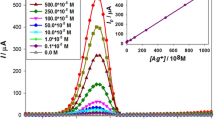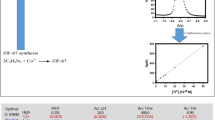Abstract
Two-dimensional (2D) COF-42 has been prepared and the COF-42/carbon paste electrode (COF-42/CPE) has been applied as a voltammetric sensor for determining copper(II). Different characterization procedures (FTIR, XRD, SEM/EDX, BET, cyclic voltammetry, and electrochemical impedance) have been implemented on the prepared COF-42 and the constructed COF-42/CPE. The central composite design has been applied for optimizing the production and function circumstances of this sensor. The existence of various functional groups in the structure of the COF-42 makes this COF greatly efficient in recognizing Cu(II) and creating stable complexes with it. The COF-42 possesses high porosity and contains various binding sites for strong interaction with copper(II), so the existence of the COF-42 in the sensor assembly decreases the mass transfer resistance in the electrode matrix and also eventuates to the precipitation of a large amount of copper analyte. The precise selection of COF and optimization of sensor preparation and operating conditions has resulted in high sensitivity and selectivity for the constructed sensor. A proper mechanism for sensor performance has been presented and confirmed by SEM/EDX and electrochemical procedures. The linear response range of the fabricated sensor is from 0.001 to 10.0 μM. The detection limit is 2.5 × 10−10 M. The analytical performance features of the proposed sensor have been explored by performing different statistical tests. Sensor performance is not affected by the presence of most potentially interfering species. The interference of silver(I) and mercury(II) was also removed by using a masking agent. Based on the experimental results and statistical tests, it was found that when using the masking agent, the precision and accuracy of the method remains at its previous appropriate value. The ability of the sensor has been confirmed in the analysis of real samples.
Graphical Abstract













Similar content being viewed by others
References
Chang S, **e W, Yao C, Xu G, Zhang S, Xu Y, Ding X (2021) Construction of 2D porphyrin-based covalent organic framework as adsorbent for organic dyes removal and carbon dioxide adsorption. J Solid State Chem 304:122577
Xu S, Richter M, Feng X (2021) Vinylene-linked two-dimensional covalent organic frameworks: synthesis and functions. Acc Mater Res 2:252–265
Nguyen HL, Hanikel N, Lyle SJ, Zhu C, Proserpio DM, Yaghi OM (2020) A porous covalent organic framework with voided square grid topology for atmospheric water harvesting. J Am Chem Soc 142:2218–2221
Guan Q, Wang G, Zhou L, Li W, Dong Y (2020) Nanoscale covalent organic frameworks as theranostic platforms for oncotherapy: synthesis, functionalization, and applications. Nanoscale Adv 2:3656–3733
Yuan S, Li X, Zhu J, Zhang G, Puyvelde PV, Bruggen BV (2019) Covalent organic frameworks for membrane separation. Chem Soc Rev 48:2665–2681
Li H, Feng X, Shao P, Chen J, Li C, Jayakumar S, Yang Q (2019) Synthesis of covalent organic frameworks via in-situ salen skeleton formation for catalytic applications. J Mater Chem A 7:5482–5492
Zhu Q, Wang X, Clowes R, Cui P, Chen L, Little MA, Cooper AI (2020) 3D cage COFs: a dynamic three-dimensional covalent organic framework with high-connectivity organic cage nodes. J Am Chem Soc 142:16842–16848
Nguyen HL, Gropp C, Ma Y, Zhu C, Yaghi OM (2020) 3D covalent organic frameworks selectively crystallized through conformational design. J Am Chem Soc 142:20335–20339
Guan X, Chen F, Fang Q, Qiu S (2020) Design and applications of three dimensional covalent organic frameworks. Chem Soc Rev 49:1357–1384
Nagai A (2020) Covalent organic frameworks. Jenny Stanford Publishing Private Limited, Singapore
Lyle SJ, Popp TMO, Waller PJ, Pei X, Reimer JA, Yaghi OM (2019) Multi-step solid-state organic synthesis of carbamate-linked covalent organic frameworks. J Am Chem Soc 141:11253–11258
Liu X, Huang D, Lai C, Zeng G, Qin L, Wang H, Yi H, Li B, Liu S, Zhang M, Deng R, Fu Y, Li L, Xue W, Chen S (2019) Recent advances in covalent organic frameworks (COFs) as a smart sensing material. Chem Soc Rev 48:5266–5302
Li D, Li S, Huang J, Yan Y, Zhang S, Tang X, Fan J, Zheng S, Zhang W, Cai S (2021) A recyclable bipyridine-containing covalent organic framework-based QCM sensor for detection of Hg(II) ion in aqueous solution. J Solid State Chem 302:122421
Liang X, Ni Z, Zhao L, Ge B, Zhao H, Li W (2021) Multifunctional triphenylbenzene-based polyimide covalent organic framework with absolute eclipsed stacking models for fluorescence detecting of Fe3+ and electrochemical detecting of Pb2+. Microchem J 170:106663
Liu T, Cui L, Zhao H, Zhang X (2020) In situ generation of regularly ordered 2D ultrathin covalent organic framework films for highly sensitive photoelectrochemical bioanalysis. ACS Appl Mater Interfaces 12:47090–47098
Wang M, Guo H, Xue R, Guan Q, Zhang J, Zhang T, Sun L, Yang F, Yang W (2021) A novel electrochemical sensor based on MWCNTs-COOH/metal-covalent organic frameworks (MCOFs)/Co NPs for highly sensitive determination of DNA base. Microche J 167:106336
Zhao X, Guo H, Xue R, Wang M, Guan Q, Fan T, Yang W, Yang W (2021) Electrochemical sensing and simultaneous determination of guanine and adenine based on covalent organic frameworks/NH2-rG/MoS2 modified glassy carbon electrode. Microchem J 160:105759
Benedetto GED, Masi SD, Pennetta A, Malitesta C (2019) Response surface methodology for the optimization of electrochemical biosensors for heavy metals detection. Biosensors 9:26. https://doi.org/10.3390/bios9010026
Korolev I, Altınkaya P, Halli P, Hannula P, Yliniemi K, Lundström M (2018) Electrochemical recovery of minor concentrations of gold from cyanide-free cupric chloride leaching solutions. J Clean Prod 186:840–850
Huang X, Sun C, Feng X (2020) Crystallinity and stability of covalent organic frameworks. Sci China Chem 63:1367–1390
Xu H, Gao J, Jiang D (2015) Stable, crystalline, porous, covalent organic frameworks as a platform for chiral organocatalysts. Nature Chem 7:905–912
Zhu L, Zhang Y (2017) Crystallization of covalent organic frameworks for gas storage applications. Molecules 22:1149. https://doi.org/10.3390/molecules22071149
Wei D, Zhang A, Aye Y, Wang X (2020) Adsorption properties of hydrated Cr3+ ions on schiff-base covalent organic frameworks: a DFT study. Chem Asian J 15:1140–1146
Lu Q, Ma Y, Li H, Guan X, Yusran Y, Xue M, Fang Q, Yan Y, Qiu S, Valtchev V (2018) Postsynthetic functionalization of three-dimensional covalent organic frameworks for selective extraction of lanthanide ions. Angew Chem Int Ed 57:6042–6048
Gottschling K, Stegbauer L, Savasci G, Prisco NA, Berkson ZJ, Ochsenfeld C, Chmelka BF, Lotsch BV (2019) Molecular insights into carbon dioxide sorption in hydrazonebased covalent organic frameworks with tertiary amine moieties. Chem Mater 31:1946–1955
Uribe-Romo FJ, Doonan C, Furukawa H, Oisaki K, Yaghi OM (2011) Crystalline covalent organic frameworks with hydrazone linkages. J Am Chem Soc 133:11478–11481
Ding S, Cui X, Feng J, Lu G, Wang W (2017) Facile synthesis of –C=N– linked covalent organic frameworks under ambient conditions. Chem Commun 53:11956–11959
Fan H, **e Y, Li J, Zhang L, Zheng Q, Zhang G (2018) Ultra-high selectivity COF-based membranes for biobutanol production. J Mater Chem A 6:17602–17611
Wang J, Li N, Xu Y, Pang H (2020) Two-dimensional MOF and COF nanosheets: synthesis and applications in electrochemistry. Chem Eur J 26:6402–6422
Pearson RG (1963) Hard and soft acids and bases. J Am Chem Soc 85:3533–3539
Irving H, Williams RJP (1953) The stability of transition-metal complexes. J Chem Soc. https://doi.org/10.1039/JR9530003192
Gendy EA, Ifthikar J, Ali J, Oyekunle DT, Elkhlifia Z, Shahib II, Khodair AI, Chen Z (2021) Removal of heavy metals by covalent organic frameworks (COFs): a review on its mechanism and adsorption properties. J Environ Chem Eng 9:105687
Ding S, Dong M, Wang Y, Chen Y, Wang H, Su C, Wang W (2016) A thioether-based fluorescent covalent organic framework for selective detection and facile removal of mercury(II). J Am Chem Soc 138:3031–3037
Ma L, Zhang X, Ikram M, Ullah M, Wu H, Shi K (2020) Controllable synthesis of an intercalated ZIF-67/EG structure for the detection of ultratrace Cd2+, Cu2+, Hg2+ and Pb2+ ions. Chem Eng J 395:125216
Wang Y, Wu Y, **e J, Hu X (2013) Metal–organic framework modified carbon paste electrode for lead sensor. Sens Actuators B Chem 177:1161–1166
Zhang Y, Yu H, Liu T, Li W, Hao X, Lu Q, Liang X, Liu F, Liu F, Wang C, Yang C, Zhu H, Lu G (2020) Highly sensitive detection of Pb2+ and Cu2+ based on ZIF-67/MWCNT/Nafion-modified glassy carbon electrode. Anal Chim Acta 1124:166–175
Skene WG, Lehn JP (2004) Dynamers: polyacylhydrazone reversible covalent polymers, component exchange, and constitutional diversity. PNAS 101:8270–8275
Miller JN, Miller JC (2010) Statistics and chemometrics for analytical chemistry, 6th edn. Pearson Education Limited, Harlow, p 117
Speight JG (2005) Lange’s handbook of chemistry, 6th edn. McGraw-Hill, New York, p 1.402
Speight JG (2005) Lange’s handbook of chemistry, 6th edn. McGraw-Hill, New York, p 1.331
Speight JG (2005) Lange’s handbook of chemistry, 6th edn. McGraw-Hill, New York, p 1.358
Speight JG (2005) Lange’s handbook of chemistry, 6th edn. McGraw-Hill, New York, p 1.31
Watanabe K, Tanaka T, Iburaim A, Itagaki M (2001) Effects of masking agents on the separation of copper(ii) from iron(iii) by continuous solvent extraction with 8-hydroxyquinoline. Anal Sci 17:671–674
Sreekumar NV, Nazareth RA, Narayana B, Hegde P, Manjunatha BR (2002) Indirect complexometric determination of mercury(II) using potassium bromide as selective masking agent. Microchim Acta 140:63–67
Shi X, Huang S, Yeap TS, Ong SL, Ng HY (2020) A method to eliminate bromide interference on standard COD test for bromide-rich industrial wastewater. Chemosphere 240:124804
Thommes M, Kaneko K, Neimark AV, Olivier JP, Rodriguez-Reinoso F, Rouquerol J, Sing KSW (2015) Physisorption of gases, with special reference to the evaluation of surface area and pore size distribution (IUPAC technical report). Pure Appl Chem 87:1051–1069
Sotomayor FJ, Cychosz KA, Thommes M (2018) Characterization of micro/mesoporous materials by physisorption: concepts and case studies. Acc Mater Surf Res 3:34–50
Sing KSW, Williams RT (2004) Physisorption hysteresis loops and the characterization of nanoporous materials. Adsorp Sci Technol 22:773–782
Field LD, Sternhell S, Kalman JR (2013) Organic structures from spectra, 5th edn. Wiley, Hoboken, p 32
Pavia DL, Lampman GM, Kriz GS, Vyvyan JR (2015) Introduction to spectroscopy, 5th edn. Cengage Learning, Stamford, p 52
Pisarenko LM, Nikitin AV (1995) Dipole moments of the carbonyl groups in cyclic β-diketones from IR spectroscopy data. Russ Chem Bull 44:670–677
Author information
Authors and Affiliations
Corresponding author
Ethics declarations
Conflict of interest
The authors declare that they have no conflict of interest.
Additional information
Publisher's Note
Springer Nature remains neutral with regard to jurisdictional claims in published maps and institutional affiliations.
Rights and permissions
Springer Nature or its licensor (e.g. a society or other partner) holds exclusive rights to this article under a publishing agreement with the author(s) or other rightsholder(s); author self-archiving of the accepted manuscript version of this article is solely governed by the terms of such publishing agreement and applicable law.
About this article
Cite this article
Zanganeh, A.R. COF-42 as sensory material for voltammetric determination of Cu(II) ion: optimizing experimental condition via central composite design. J Appl Electrochem 53, 765–780 (2023). https://doi.org/10.1007/s10800-022-01798-4
Received:
Accepted:
Published:
Issue Date:
DOI: https://doi.org/10.1007/s10800-022-01798-4




